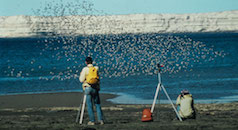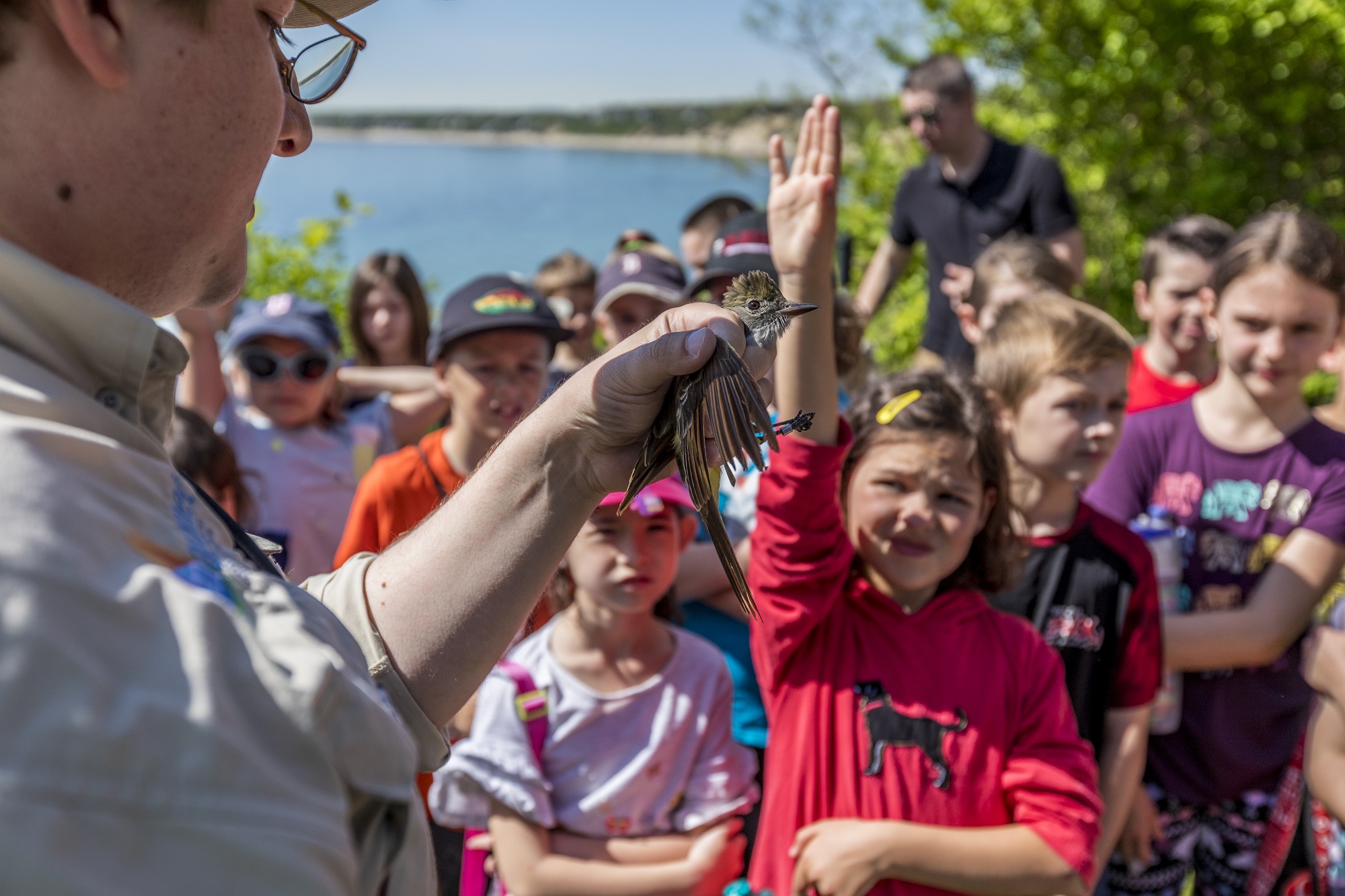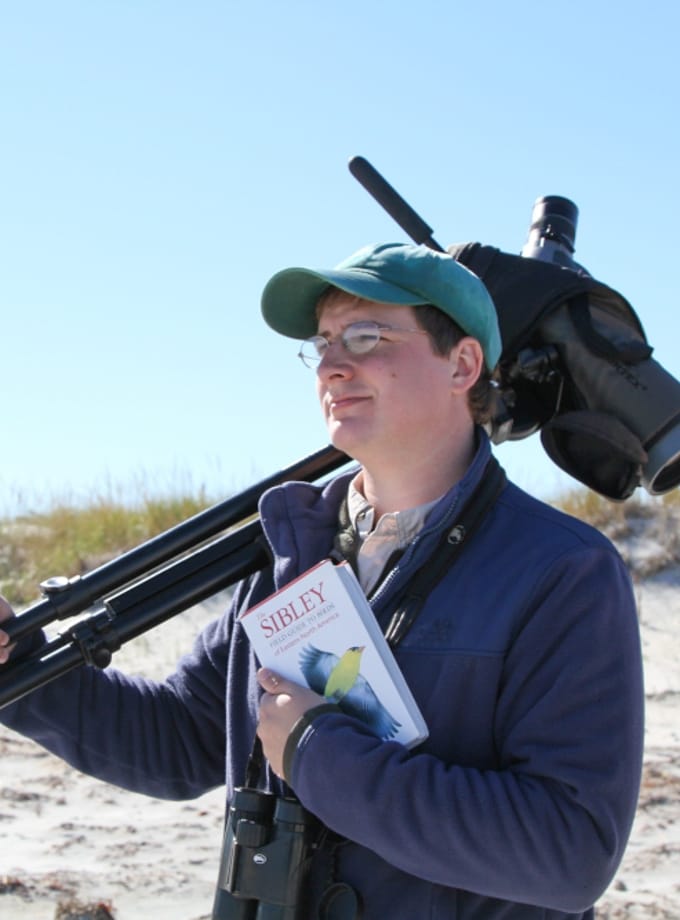This weekly list consists of bird species—both year-long residents and migratory—you may find in your backyard in the northeast U.S.
Our goal is to help you get to know the birds using your area, both through our staff’s birding expertise as well as what Manomet has learned about these species from our over 50 years of studying them in our banding lab.
Scroll through this page to see weekly species accounts by month.
Go back to all Backyard Birding
April
BLACK-CAPPED CHICKADEE

Perhaps fitting that this is our first bird, since the Black-capped Chickadee is our state bird and Manomet’s first logo! Despite its diminutive size, the Black-capped Chickadee is a hardy, year-long resident of the Northeast. Totally distinctive in its appearance, the Black-capped Chickadee sports a jet-black cap and bib that contrast sharply with its bright white cheeks. Many people are familiar with the chickadee’s spunky call of “chick-a-dee-dee-dee,” but, beginning on warm sunny days in the late winter, you can also hear their song—a pair of laid back, whistled notes.
TUFTED TITMOUSE
Tufted Titmice (pictured below, left) are the bad boy cousins to chickadees. Slightly larger than chickadees, titmice sport an adjustable mohawk of feathers and a bundle of attitude. Titmice are also non-migratory, but over the last century, ornithologists have noticed a northward range expansion (we’ve noticed it in our banding data as well). Their most common song is a whistled, repeating “peter peter peter.” This time of year, though, titmice can make a whole bunch of interesting calls and songs, often with a burry quality. Listen to some of their calls here and I bet you’ll find one that you’ve heard in your yard. Both chickadees and titmice nest in tree cavities and will visit your seed feeders.

DOWNY WOODPECKER
Probably the most common woodpecker at backyard suet feeders, the Downy Woodpecker (pictured above, right) is also the smallest in the Northeast. Dressed in black and white polka-dots (males have a red spot on the back of their heads), Downy Woodpeckers are only slightly larger than a sparrow. They don’t have a proper song, but their piercing ‘PIK’ call is commonly heard in backyards (and through windows). We can also sometimes see the less common Hairy Woodpecker which is much larger (noticeably larger than commercial suet cakes), has a longer bill, and lacks black spots on its outer tail feathers.
AMERICAN ROBIN

American Robins were once considered the harbingers of spring. In many ways they still are. Although they can be seen year-round, the birds roaming the frozen lands in search of midwinter berries are actually visitors from the north. Most robins that breed in Massachusetts spend winters further south. Some of our banded robins have been encountered on the gulf coast of Texas! The rollicking song of the robin is a welcome addition to the late winter/early summer dawn chorus. Robins often start singing before dawn.
MOURNING DOVE
If you sprinkle cracked corn on the ground near your feeders, you’ll probably get a visit from a Mourning Dove or two. With a long tail, rotund body and pinkish-clay hue, the Mourning Dove is quite beautiful. Males often sport a bluish cap as well. Since they are a favorite prey of local Cooper’s Hawks, this species is quite nervous and often takes off at the first sight of danger. Their wings make a distinctive whistling sound. Mourning Doves have a cooing song that some might confuse for an owl; you won’t typically hear a dove singing in the dark though. This is one of our earliest breeding birds; there could be Mourning Dove nests already this year! When we band Mourning Doves, we measure their tails to help us determine their sex (males have longer tails).
WHITE-BREASTED NUTHATCH
The upside-down bird (aka nuthatch) is a true acrobat of the backyard. They climb trees like woodpeckers, but are much more agile. Instead of relying upon their tails to assist in climbing, nuthatches only use their oversized feet. A typical position is head-down, something that woodpeckers just can’t do! A common visitor to backyard feeders, the White-breasted Nuthatch will typically fly in, grab one seed, and fly off to consume it. The name ‘nuthatch’ comes from their habit of wedging a seed or nut in a crevice and whacking (hatching) away at it with their bills. Even if you don’t see them, their nasal call or laughing song will betray their presence. White-breasted Nuthatches are cavity nesters. As such, many bird banders believe that they smell like trees!
AMERICAN GOLDFINCH

The American Goldfinch is a small, but exciting addition to your backyard birds. Although they look rather drab over the winter, these bright, lemon-yellow birds seem to materialize out of nowhere once the males start molting (replacing their feathers) in late winter. The bird in this photograph is still in mid-molt and you can see a mix of older, winter feathers being replaced by the bright breeding plumage. American Goldfinches are almost exclusively seed eaters; are also the only local species that feeds their young seeds instead of invertebrates. Often confused for warblers, these birds are easily distinguished by their thick, conical bill. Although they can be found in the northeast year-round, American Goldfinches are prone to wandering. We often catch small charms (the word for a flock of goldfinches!) in our nets along the coast. We have captured banded goldfinches from as far away as Florida!
BLUE JAY

Gregarious and bombastic, Blue Jays don’t often go unnoticed in the backyard. Although they get a bad reputation for robbing other birds’ nests and making a mess of feeders (which they do sometimes do), the interest they lend to a backyard far outweighs these apparent downsides. As corvids (the same family as crows and ravens), Blue Jays are highly intelligent and social. They are able to imitate raptors, and it is thought that they may do so to scare other birds away from feeders or to alert other birds of the presence of a real hawk. Blue Jays are important dispersal agents of oak trees; their storage of acorns for winter food often leads to new oak trees in faraway places. Through our banding data, we have noticed their early season spring movement up the Atlantic coast is occurring earlier and earlier each year.
NORTHERN CARDINAL

A year-round resident of most backyards, the Northern Cardinal is a welcome visitor to seed feeders, especially in the winter, when their bright red color pops against a wintry backdrop. Although not as gaudy as their male counterparts, female cardinals are equally pretty; a combination of clay and rosy hues. Both males and females sing their syrupy song and pairs of cardinals maintain territories throughout the year. Cardinals use their huge, orange bills (young cardinals have duller, smudgy bills) to crush seeds. They are one of the few backyard birds that can open the tough hulls of safflower seeds. Using this seed will help eliminate unwanted seed-stealers like squirrels, while allowing cardinals to eat undisturbed. Although they will visit feeders, cardinals actually prefer to forage for seeds on the ground. The number of Northern Cardinals banded annually at Manomet has greatly increased since the 1970’s. This is probably due to an increase in breeding habitat, milder winters, and more bird feeders!
HOUSE FINCH

Although it seems a natural part of our backyard birdscape, the House Finch is actually an introduced species East of the Rockies. Prior to the Migratory Bird Treaty Act of 1918, House Finches (native to the American West) were quite popular as caged pets. In response to the new regulations, House Finch owners and sellers released their caged birds, and by the 1940’s, House Finches had started to colonize the eastern U.S., displacing native species like the Purple Finch in the process. Throughout their range, House Finches are quite comfortable dwelling near humans. They visit seed feeders and often nest in ledges of man-made structures. In the last few years, House Finches have nested under the eaves of Manomet’s teahouse. Male House Finches are primarily brown with a bright, strawberry-red wash over their head and upper breast. Female House Finches are a sandy-brown color above and paler below. Although they have breast streaking, like Song Sparrows (see below), the paler House Finch prefers to perch in the open.
CAROLINA WREN
The merry ‘tea-kettle’ song of the Carolina Wren is a fixture of most suburban backyards in the east. If you are able to catch a glimpse, they are rather dapper; sporting a coat of rusty orange and a bright-white eyebrow. This lively little bird can be hard to spot, as it likes to nest in the shadowy recesses of a wood pile, shed, or other crevice. Male wrens will build multiple nests to impress a female. Carolina Wrens famously build nests everywhere, including in hanging plants and even clothes on the clothesline! The female picks only one of these nests and lines it by herself. As their name suggests, Carolina Wrens are a bird that is expanding northwards. In colder winters with lots of snow cover (when other southerners like cardinals can take advantage of birdseed feeders) many members of this non-migratory species perish. We see these fluctuations in our banding data at Manomet. You can help your neighborhood Carolina Wrens survive harsh winters by feeding suet over the winter.
SONG SPARROW
The Song Sparrow is probably the most common ‘little brown job’ (or LBJ) in your backyard. Small and long-tailed with a dark moustache, streaks on the side, and a central spot on the breast, this sparrow can be found in every state, except Hawaii, so it’s a good one to know! Even if you’ve never knowingly seen a Song Sparrow, their song is probably familiar. A skulker by nature, this species nests in low, grassy thickets or at the edges of ponds. If a predator gets too close to their nest, they will sometimes attempt to lure it away by feigning injury.
This spring 2022 migration season, for the first time in Manomet history, you can adopt one of the mist nets we use to safely capture birds for research! By adopting a mist net in your name or a loved one’s, you will support critical bird and ecology research and help educate the next generation of conservationists.





 Back to all
Back to all



